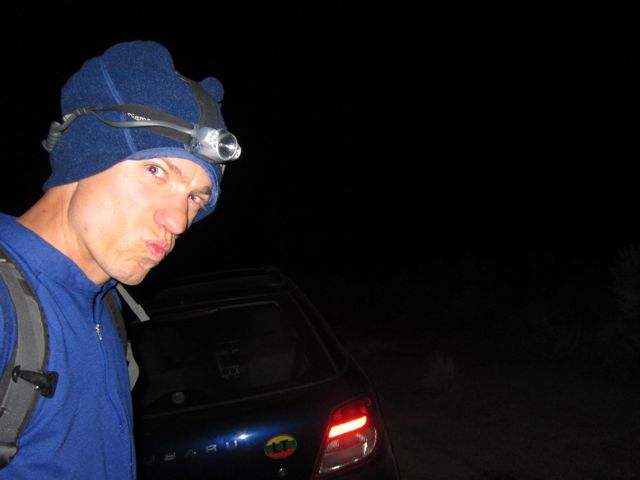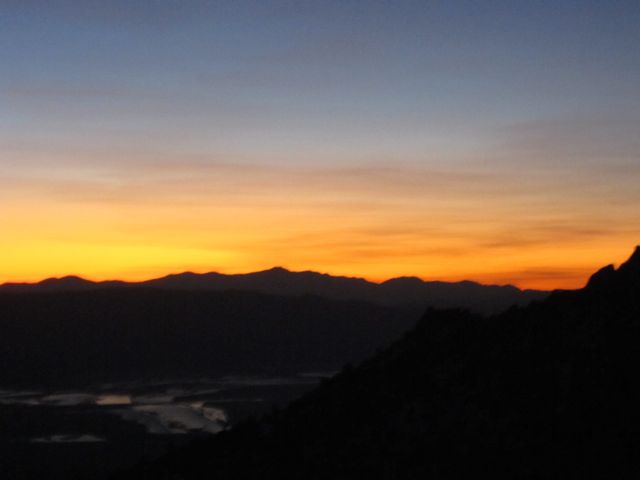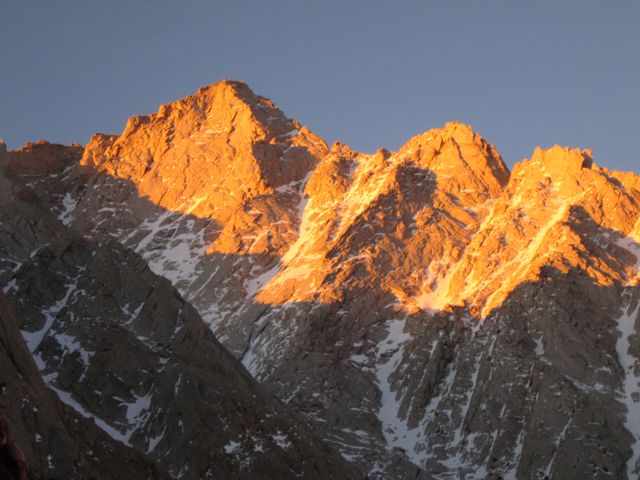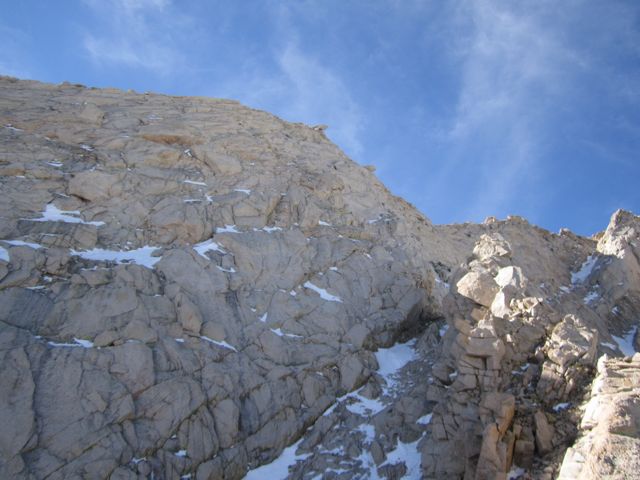Single Push of NE Ridge of Lone Pine Peak in Winter

“I believe. I believe. I believe.” Staring at the ceiling of my car, parked at the foot of Lone Pine Peak. 2:45 a.m. on a February morning, trying to psyche myself through the doubts that kept creeping through my head. “It is within me. Believe.”
Summit shot with Mt. Whitney and Mt. Russell on the right.
The NE Ridge of Lone Pink Peak, one of the Sierra’s quintessential alpine climbs, a pure 7000’ ridge and nothing else. Rising from the desert floor from sand that soon morphs to perfect granite. It’s commonly soloed in summer, but in winter, to my knowledge, it has seen no winter solo and no single push ascent. Alois Smrz did the First Winter Ascent (TR here); the fastest Winter ascent was done by a Pullharder crew, spending two nights on the ridge (TR here). The route has been on my radar for a few years due to its huge stature and the fact that it looms over you as the most eye-catching feature every time you drive up US 395.
The NE Ridge of LPP jumped up on my A-list when Dale Apgar asked me to climb it with him earlier this month. It didn’t work out and Dale tried to go for the solo. Unfortunately conditions conspired against him and he made it about halfway before having to bail. Then, my interest rose further when I spent last weekend with Nate Ricklin who told me that Pullharder's ascent of the nearby North Ridge, its first single push ascent in Winter, was one of his proudest Sierra accomplishments (it’s also one of Pullharder’s most insane and best trip reports, see here). Hearing him talk about the experience with such zeal and fire really made me stoked on the peak. The NE ridge still needed a single push Winter ascent.
By Wednesday, the hype in my mind had risen to a furor; I had to drop everything and go for it. The only problem was, I doubted myself. To blitz the route car-to-car seems the best way to climb it (though, truthfully, I don’t know if there’s a climb where I don’t think single push is the way to go). I have very good cardio, lots of experience and a cool head, so it was a reasonable goal. But I was scared.
The approach is maybe 10 minutes and this year lower ridge snow conditions are light. It’s only 5.7 with the direct finish. I’ve soloed much bigger and harder things, even earlier this month on neighboring Mt. Whitney (TR here). Why did this climb cast such doubts for me? I hadn’t been this scared in many years.
To gain confidence I called Gil Weiss, who owns the fastest summer solo time on the route, 5 hours. To my almost surprise, Gil thought I would crush the route in a day in Winter, no problem. He almost talked about it as an afterthought. There was never a waver of doubt in his support for the ascent. Stoked, I finished out the school day then jumped in the car just in time for rush-hour traffic.
On the drive up to Lone Pine the doubts returned and I called my often-partner Konstantin Stoletov, who had also soloed the route in summer. Konstantin kept reiterating that he was proud of me for getting after it this Winter and expressed no qualms whatsoever about it being a reasonable objective for me. No one had done it. But if my climbing partners know the route and know my ability and think I’ll cruise it, why is it that I can’t convince myself?
When I was 22, I oozed confidence. As a Ranger at Philmont, the hardest hiking challenge was the 60 mile Conservation Marathon, from end to end of the Philmont domain with 30-pound pack and a conservation tool. The record was 27 hours. With much hubris I declared I could do it in 20; to force the point I would start at midnight. With nightfall at 8pm, if I didn’t go under 20 hours, I would not be able to find the finish, a cabin remote in the woods, 3 miles off of any trail. All or nothing. And I did it, 19:52, and the hardest day of my life.
The next year I wanted to climb Khan Tengri, the northernmost 7000m peak in the world and a most beautiful and difficult summit. But knowing no partners who were up to the challenge, and not believing in jugging ropes, I would solo the thing, including the 5.8 vertical pitch at 6800m. I am not sure where I got those kind of cahones, but I never felt that I would fall; I several times wanted to turn back due to exhaustion (I had climbed it alpine style) but indeed persevered to summit this amazing marble pyramid. To this day I consider it the second hardest day of my life.
Those challenges were much bigger-- why was I getting hung up on Lone Pine Peak? I actually, deep down, knew the reason. I was scared I couldn’t zoom fast enough unroped in the icy conditions on a low-angle route.
While soloing is indeed mentally challenging (Josh Higgins has a good report on the soloing psychology here), soloing doesn’t make me scared. Indeed, when I choose to solo something, it is calm, collected, almost matter-of-fact. I’m not going to fall, and I climb carefully, securely and deliberately to guarantee it.
What actually psyched me out about the NE ridge of LPP was not the difficulty. It was that the route is low angle, meaning more snow and ice stays on the route than on a steep face. In winter, mid-5th friction climbing (and even 4th class) is dicey--and icy. That doesn’t mean I’d fall. It just means lots of time and precautions to make sure I won’t fall. Which means blitzing the route before night falls on me while still being safe is the real challenge. I envisioned myself running out of light and having to rush things that I should be taking methodically. Or bivying with no gear. These possibilities really made me scared, and for no real reason; I'd done it before. I actually think the psychological failure of a single-push would be harder than the bivy, and I think I deeply needed to succeed for my own psychology. I needed to believe in myself more.
Where was this confidence I had when I was younger? Some people say you get wiser as you get older, and take less risks. But I don’t think it’s about risks or fear and falling. It’s about some deep belief in yourself, a self confidence. When I was 23 I had never failed to send any alpine route I had tried. Ever. I had never taken any big or scary lead falls. I had never fallen into crevasses, never failed at relationships, never fought with my family, never been rejected when asking for a date, never had to study more than an hour for an exam, or felt any sort of vulnerability whatsoever.
At age 31, all of these things have happened, and likely as a result, I can’t garner the same chutzpah I did before. And that’s ok. Naïve confidence is undesirable. I just wanted some genuine confidence for one route that seemed well within my capabilities. My speed climbing, route-finding and soloing ability were all there in order to send the route. My friends knew it. And I knew it. But why didn’t I, deep in my being, believe it?
I got going at 3:31. It was warm, so I often poked through the snow on the lower ridge. A little slow, but no problem, I’m good at slogging. Conditions for approaches are good this year for the Sierra, which means fast times. But what really matters is route conditions, and those aren’t really affected much by the low snow year. Whether a part of the climb is icy or not depends little on how deep the approach snow is and more on the recent weather in the past days.
2.5 hours later, the sun rose and the climbing became sustained, and indeed, the route was often covered with snow and ice. Putting on my rock shoes, I enjoyed the spectacular granite, being careful to climb around snow and ice as much as possible. It was still a cardio workout as you can hear in the video:
When soloing in the mountains, I climb very securely, putting all points on in case something breaks. And indeed they did, probably 5 times. Usually it was those little Toulomne knobs under my foot-- they’d sheer off into the chasm below. But as I’d always have secure hands and a second foot, there wasn’t even a raised heart rate. I thought to myself “these loose holds are due to virgin territory, the summer's easiest route being impassible due to snow and ice. Or, maybe I am just heavier than other climbers due to my huge cahones.” Yes, my confidence was indeed coming back.
Nate’s trip report was accurate in that he talks about the icy slabs and a burly lieback as the mental cruxes in Winter. The lieback in particular, with slab feet on ice and lichen was especially insecure. You fall, you die, dog. But I wasn’t going to fall; Ash Wednesday was just yesterday and it wasn't already time to return to the dirt. I just found a different foot, doing a slab stem and another high foot, pulling the move without a lieback in a more difficult, but secure, way. A 100% success rate for pulling a move in a 5.8 way is better than 99% success pulling it the easiest 5.6 way.
Every third move I had to wipe my shoes from grit, snow, and water. As long as they were clean, I was safe. I would go left, right, over the crest, back, trying to find the safest way. This ate up time but I wanted to be safe. It was still a very cardio activity, I was always moving. I only made a few notable routefinding errors which I easily corrected and only cost maybe 5 minutes each. Then, almost surprisingly, I pulled onto the summit plateau. Was I already done? I checked my watch, 7 hours flat. 19 more minutes of postholing in my rock shoes gained the summit proper. I couldn’t find the summit register, I guess it was buried in snow. I shot a video and had some lunch in the sun.
I had only had 2 quick bites during my blitz of the route but I wasn’t too hungry. It was still before 11am! I took it leisurely on the way down the East Ledges, enjoying the Winter afternoon and sun on Lone Pine Peak. Instead of taking the road I traversed across the base of the mountain back to the car. This is definitely not faster, because you have to go up and over many little ridges on sand. But it’s a more natural way, I think, and leaves you up on the mountain longer.
I had brought crampons (against Gil’s advice, but I was scared I might need them if I had to bail to the gulley), a rap cord, and an axe, but all were unnecessary. The route was all rock and the descent was soft snow. Apparently there’s a rappel on the first tower. Well, there are like 20 towers, and the only place I saw a rap station was the second-to-last one, which was only 5.8 downclimbing and secure and ice-free because it's a bit overhanging. Summitpost's route description reads "Recommended for those, who like to suffer. Great (and long) ALPINE route!" I would edit the first sentence out. There was no suffering, only an aesthetic ridge and the overwhelming beauty of the snow-covered Sierra.
Back at the car before 3pm, it was over so fast; the fear I had built up in in my head was overblown. I got back to San Diego in time for dinner in 27 hours r/t. Konstantin and Gil were right. Weak faith, I only believed I would send after the fact. But it goes in the bank of confidence for next time. As long as I don't lose it by getting shot down on my next date...
The North Ridge of Lone Pine Peak at sunrise as seen from my route, the NE Ridge
Ben Horne
Feb 23, 2012
Solo Winter Ascent of NE Ridge of Lone Pine Peak from the Desert Floor
7h 00m to top of ridge, 7h 19m to summit, 11h 25m car-to-car
































